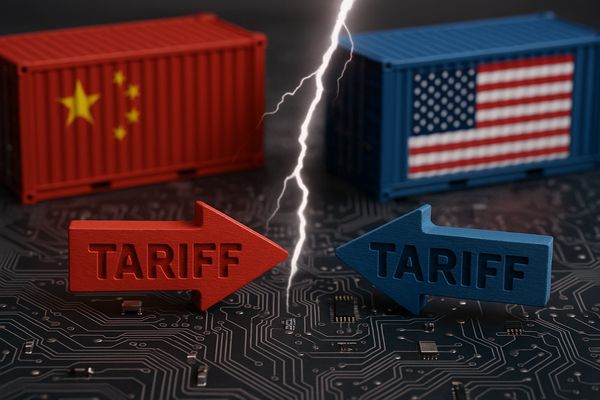
Tariff Tantrum 2: Renewed U.S.-China trade tensions are reshaping global supply chains and rattling multinational earnings. Policymakers are weighing fresh duties and export controls now, and companies are racing to reroute production, lift costs, and hedge geopolitical risk. In the short term, markets see higher volatility and pressure on margin-sensitive sectors. In the long term, multinationals face a structural re‑routing of supply chains toward India, Southeast Asia, and onshore hubs. The move matters across regions: US and European firms confront cost and compliance risks; Asian suppliers face both opportunity and disruption; emerging markets get investment but also competitive strain. The trend echoes the 2018–19 tariff shocks but is amplified by AI hardware demand and tighter export controls.
Tariffs and Tech: Immediate Ripples for Apple, Amazon and Chip Suppliers
Renewed tariff risks hit consumer electronics and cloud hardware hard. Apple (NASDAQ:AAPL) and Amazon (NASDAQ:AMZN) sit at the center. Both companies source components and assemble devices across China, Taiwan, and Southeast Asia. Tariff announcements raise near‑term costs and force rapid supplier reshuffles. Taiwan Semiconductor Manufacturing (NYSE:TSM) expects a strong Q3, but higher trade friction complicates logistics for foundries serving AI demand.
Semiconductor equipment suppliers are sensitive too. Lam Research (NASDAQ:LRCX) and Broadcom (NASDAQ:AVGO) are embedded in the AI hardware chain. Any escalation that restricts exports or raises import levies could raise capex costs for hyperscalers and OEMs. Microsoft (NASDAQ:MSFT) and Alphabet (NASDAQ:GOOGL) face the risk of increased server costs even as they spend to scale AI infrastructure.
Why It Matters Now: Timing, AI Demand and Supply‑chain Momentum
Policymakers have signaled new measures, and markets react fast. The timing matters because AI hardware demand already tightens supply. When tariffs or controls appear alongside booming data‑center orders, firms face a double squeeze: higher duties and constrained input availability. That amplifies volatility for growth ETFs that concentrate on big tech names, such as the QGRW thematic highlighted in recent coverage.
History provides a template. The 2018 tariff cycle forced many companies to diversify manufacturing and absorb margin hits before normalizing prices. This time, the transition costs come amid heavy investment in AI servers and software. That raises the stakes for companies that reported mixed near‑term execution — for example, Accenture (NYSE:ACN), which is expanding AI services with Google Cloud’s Gemini while simultaneously grappling with modest margin softness. Professional services and cloud integrators can help clients re‑architect supply chains, but they also see their own revenue and margin cycles affected.
Markets and Sentiment: ETFs, Banks and Volatility Signals
Investors are pricing uncertainty. Broad indices have treated the move so far as a dip rather than a collapse, with AI leaders maintaining relative strength. Still, cyclical and trade‑sensitive stocks underperformed. Bank earnings weeks, led by names like JPMorgan (NYSE:JPM), provide a barometer: credit quality, trade finance flows, and corporate guidance will reflect the real economic impact of tariff moves.
ETF flows also matter. Growth‑and‑quality funds that overweight large‑cap techs may see larger drawdowns as rebalancing and volatility increase. That dynamic can accelerate in the short term as algorithms and passive flows amplify directional moves. Meanwhile, fund managers at BlackRock (NYSE:BLK) and alternative firms like Blue Owl (NYSE:OWL) will weigh reallocation between public and private, and between regions, as they respond to shifting risk premia.
Sector Watch: Healthcare, Industrials and Energy Respond Differently
Not every sector feels tariffs the same way. Healthcare names such as Amgen (NASDAQ:AMGN) are cushioned by strong institutional ownership and product demand, though supply chains for active pharmaceutical ingredients still cross borders. Johnson & Johnson (NYSE:JNJ) eyeing targeted deals shows how M&A can be a strategic lever when production footprints need reshaping.
Industrial and energy firms face mixed outcomes. Offshore and materials players such as Transocean (NYSE:RIG) and energy midstream names see commodity and export shifts that interact with trade policy. Real estate and REITs adjust capital moves and issuance timing as borrowing costs and cross‑border investment flows change.
What Comes Next: Data, Earnings and Policy Signals to Watch
In the near term, watch three readouts. First, central trade announcements and any export‑control specifics that target semiconductors or AI components. Second, corporate guidance from big tech and chipmakers — notably TSMC’s quarterly cadence — which will show whether cost pass‑through or margin compression appears. Third, earnings from major banks and industrial exporters that reveal order trends and trade finance stress.
Longer term, expect a phased re‑orientation of plants and contracts. That will bring both one‑off costs and a durable shift in supplier geographies. Companies with flexible contract structures, diversified sourcing, and services‑led revenues may weather the transition more smoothly. Policymakers and corporate boards will drive the tempo. Investors and analysts should focus on incoming policy details, capex plans, and supply‑chain disclosure in upcoming earnings calls.
Upcoming items to track include major bank earnings, TSMC’s Q3 results, and any fresh US‑China announcements. Those will sharpen the picture of how intense and persistent this tariff cycle could be.












